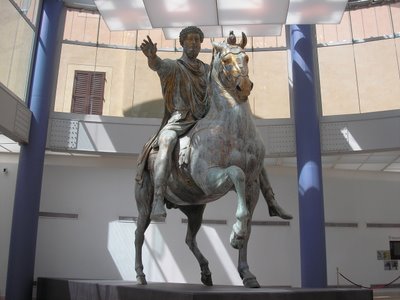Henry James and the Equestrian Marcus Aurelius
In the Michelangelo-designed piazza on the Capitoline hill is a giant bronze statue of Marcus Aurelius on horseback:
The above sculpture, however, is a copy. The real one has been moved inside the museum and is no longer exposed to the elements. It is now housed in the same room as the giant bronze of Constantine, a photo of which I posted the other day:
The sculpture, justifiably famous, has long provoked comment. Here are Henry James' thoughts, taken from his essay 'A Roman Holiday', which is collected in Italian Hours:
The legendary wolf of Rome has lately been accommodated with a little artificial grotto, among the cacti and the palms, in the fantastic triangular garden squeezed between the steps of the church and the ascent to the Capitol, where she holds a perpetual levee and "draws" apparently as powerfully as the Pope himself.
Above, in the piazzetta before the stuccoed palace which rises so jauntily on a basement of thrice its magnitude, are more loungers and knitters in the sun, seated round the massively inscribed base of the statue of Marcus Aurelius. Hawthorne has perfectly expressed the attitude of this admirable figure in saying that it
extends its arm with "a command which is in itself a benediction." I doubt if any statue of king or captain in the public places of the world has more to commend it to the general heart. Irrecoverable simplicity--residing so in irrecoverable
Style--has no sturdier representative. Here is an impression that the sculptors of the last three hundred years have been laboriously trying to reproduce; but contrasted with this mild old monarch their prancing horsemen suggest a succession of
riding-masters taking out young ladies' schools. The admirably human character of the figure survives the rusty decomposition of the bronze and the slight "debasement" of the art; and one may call it singular that in the capital of Christendom the portrait most suggestive of a Christian conscience is that of a pagan
emperor.


2 comments:
What he says at the end there is particularly interesting, considering the reason this statue of a pagan lasted the medieval period was because it was thought to be of Constantine.
Yes, I hadn't thought of that. Perhaps that's why it was thought to be Constantine--because of the conscience suggested in the portrait?
And they must have also thought that Constantine had a beard!
Post a Comment